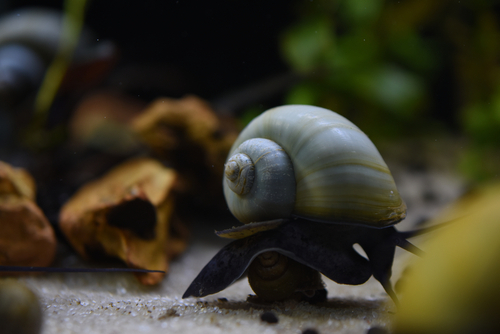Mystery snails, scientifically known as Pomacea bridgesii, are a popular choice for freshwater aquarium enthusiasts due to their striking appearance, peaceful temperament, and beneficial algae-eating habits.
Originating from South America, these snails can be found in countries like Peru, Paraguay, Brazil, and Bolivia.
As members of the Ampullariidae family, mystery snails have a unique shell design and come in a variety of colour variations, making them a visually appealing addition to any aquarium.
Mystery snails are not just a feast for the eyes with their unique shell design and array of colours, but they also play a vital role in maintaining a clean and healthy tank environment.
Growing up to a substantial 2 inches in diameter, these snails are often mistaken for other species. However, their distinctive colouration and ability to thrive even in small tanks of just 5 gallons (20L) set them apart.
Caring for mystery snails is an adventure in itself. It involves understanding their dietary preferences, creating the ideal habitat, and choosing suitable tank mates.
With the right care, these fascinating creatures will not only survive but thrive, contributing to a vibrant, harmonious, and engaging aquarium environment. So, are you ready to unravel the mystery of these captivating creatures?
Contents
Mystery Snail Basics
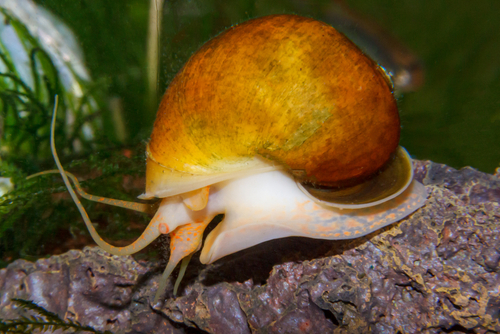
Distribution
The mystery snail (Pomacea bridgesii) is a popular type of freshwater snail that originates in South America, with the highest density found in countries such as Peru, Paraguay, Brazil, and Bolivia.
Often referred to as the spike-topped apple snail or common apple snail, it can be found in various aquatic habitats, including rivers, lakes, and swamps.
Size
Mystery snails may be small in stature, but they certainly make up for it with their striking appearance and beneficial habits. Their shells, which can range from earthy browns to creamy whites, are a sight to behold.
Each shell is uniquely patterned, often displaying a gradient effect or adorned with light brown, dark brown, or black stripes and markings. This variety in shell design adds a touch of visual intrigue to any aquarium.
But these snails aren’t just about looks. Known for their peaceful demeanour and slow-paced lifestyle, mystery snails are diligent cleaners of their aquatic environment, consuming excess food, waste, and algae found on aquarium decor, gravel, glass, and plants. That keeps the tank clean and contributes to a healthier environment for other tank inhabitants.
Anatomy and Appearance
Pomacea bridgesii possess a unique anatomy that is both fascinating and practical. The most prominent feature of these snails is their hard, protective shell.
Made of calcium carbonate, this shell grows alongside the snail throughout its life, providing the necessary protection from predators and environmental challenges.
In addition to the shell, mystery snails have gills and a lung, allowing them to thrive in both oxygen-rich and oxygen-poor water conditions.
They use their siphon, a tube-like appendage, to draw in water for respiration through their gills. However, in low-oxygen environments, their lung enables them to breathe air from the water’s surface.
These snails exhibit a vast range of colours, including shades of gold, blue, black, and ivory. This natural variation makes them an attractive choice for many aquarium enthusiasts.
Other unique features of mystery snails are their tentacles and operculum. They have two sets of tentacles – long ones that detect their surroundings and a shorter pair for smelling and tasting. The tentacles help in navigation and gathering information about their environment.
The operculum, a disc-like plate located on the rear of their foot, acts as a trap door. When the snail retracts into its shell, the operculum seals the opening, providing an extra layer of protection against predators and dehydration.
Mystery snails’ distinct anatomy and appearance contribute to their popularity in freshwater aquariums and make them fascinating creatures to observe and care for in a well-maintained aquatic environment.
Shell Colors and Patterns
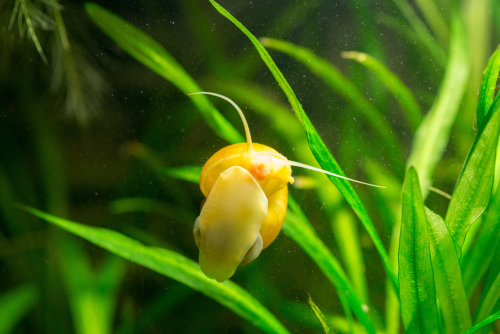
Mystery snails are known for their attractive shells, which come in a variety of colours and patterns. These striking features are one of the reasons why they are highly sought after by aquarium enthusiasts.
The colours of mystery snail shells include black, brown, blue, white (ivory), golden, and purple. The variation in colouration makes them visually appealing and easily distinguishable from other snail species.
The albino mystery snail is one of the rarest colour types, adding a unique aesthetic to any aquarium setup.
Shell patterns are another captivating aspect of mystery snail shells. Typically, the shell has a smooth surface, with whorls spiralling towards the apex. Some shells can be solid in colour, while others may feature contrasting bands or stripes, enhancing their visual appeal.
It is important to note that mystery snails can display a combination of two primary pigments, further diversifying the appearance of their shells. For example, a snail may have a base of yellow pigment with the added dimension of brown bands or stripes.
Mystery snails offer a wide array of shell colours and patterns that can complement a variety of aquatic environments. These beautiful gastropods serve as fascinating aquatic pets and provide an enriching visual experience for the aquarium enthusiast.
Diet and Feeding Habits
Mystery snails are popular invertebrates in the aquarium hobby, known for their efficient algae-eating and scavenging abilities. Their diet primarily consists of algae, detritus, and plant matter. As herbivores, mystery snails play an essential role in maintaining a clean environment when kept in an aquarium.
These molluscs are quite fond of consuming algae that grow on various surfaces in the tank, such as glass, decorations, and plants. In addition to algae, they feed on decaying plant matter and uneaten fish food.
This scavenging behaviour makes them a valuable addition to any community aquarium, as they help to keep the living space tidy.
Feeding mystery snails does not require complicated steps. Offering them a variety of blanched, calcium-rich vegetables like green beans, broccoli, cucumbers, zucchini, and peas can be done regularly.
On a weekly basis, copper-free algae wafers or fish pellets can also be provided as part of their diet. It is important to ensure that mystery snails receive essential nutrients to promote a healthy shell.
Calcium-rich foods, such as spinach and kale, can be incorporated into their diet by briefly boiling the vegetables for 3-5 minutes and then cooling them in ice water before adding them to the aquarium. This process softens the vegetables, making them easier for the snails to consume.
Habitat and Tank Requirements

Mystery snails (Pomacea bridgesii) are native to South America and can be found in various freshwater bodies such as rivers, lakes, and swamps of Brazil, Bolivia, and Paraguay. They are adaptable creatures and are popular in home aquariums due to their algae-eating habits and easy-care requirements.
An essential aspect of keeping mystery snails healthy and happy is providing them with a suitable habitat, and this means setting up the ideal tank conditions.
A minimum tank size of 10 gallons (40L) is usually recommended for these snails, although a larger habitat would be more appreciated. Mystery snails grow to about 2 inches and need ample space to roam and explore their environment.
Regarding a substrate, a fine gravel or sandy bottom is preferred as it allows the snails to search for food without injury. Moreover, providing them with a substrate rich in vegetation is crucial. They love areas with decomposing or dead plants, which serve as their primary food source.
Introducing plenty of ornaments, hiding spots, and vegetation will create a more natural and engaging environment for your mystery snails. Ensure your snails have access to a suitable above-water perch where they can breathe and relax occasionally.
Finally, employing a gentle filtration system is beneficial in maintaining water quality and ensuring that the habitat remains safe and clean for your mystery snails.
Water Parameters
When setting up an aquarium for mystery snails, maintaining ideal water parameters is crucial for their health and well-being. It is essential to regularly monitor and maintain these parameters to ensure a safe and comfortable environment.
Mystery snails thrive in a pH range of 7.6 to 8.4, which is slightly alkaline. This ensures the health of their shells and overall well-being. To maintain the stability of the pH level, you can use substrate and decorations designed to buffer the water or utilise commercial pH stabilisers.
Another essential parameter is water hardness. The ideal general hardness (gH) for mystery snails is between 8-18° and carbonate hardness (kH) within a range of 12-18°.
Hard water promotes healthy shell growth and prevents shell deterioration, which can be caused by soft, acidic water. Regularly testing water hardness and using additives when needed can help maintain the required levels of gH and kH.
Water temperature plays a significant role in the life of mystery snails, with their preferred range being 68° to 84° Fahrenheit (20° to 28°C). Consistency in water temperature is crucial to avoid stressing the snails. Utilising a heater can help maintain a steady temperature inside the aquarium.
Maintaining water quality is vital to the health of mystery snails. Ensuring low levels of nitrates, ammonia, and nitrites in the aquarium can prevent health issues such as shell erosion and sluggish behaviour. Adequate filtration and frequent water changes can help keep these parameters in check.
Breeding and Reproduction
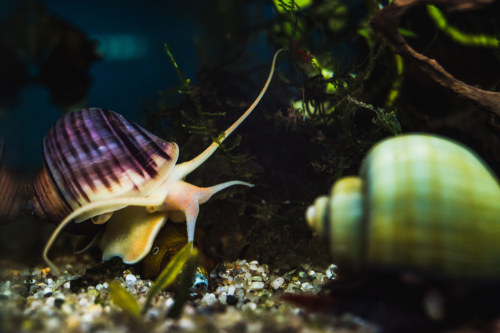
Mystery snails are popular in the aquarium hobby for their ability to clean up excess food, waste, and algae. Breeding these snails can be an exciting and rewarding endeavour for aquarium enthusiasts. They typically reach breeding age around 4 to 6 months, or when they are about 1 inch in size.
To initiate the breeding process, it is essential first to determine the gender of the mystery snails. Males and females can be distinguished by looking for their reproductive organs underneath the lip of their shells. Female mystery snails tend to develop a slightly translucent appearance when they are ready to reproduce.
Once you have identified the genders, it is recommended to place the snails in a separate tank with a consistent temperature of around 78°F (25°C). Providing ample vegetation and calcium-rich foods will ensure optimal health and encourage reproduction. Remember, these snails are not hermaphroditic, so they cannot reproduce asexually; they require a mating pair.
Upon successful mating, the female mystery snail will lay eggs above the waterline. Maintaining adequate humidity in the tank is essential to prevent the eggs from drying out.
The eggs will usually hatch within 2 to 4 weeks, depending on the surrounding conditions. Once the baby snails emerge, they can be carefully transferred to a separate tank with shallow water to ensure their survival and growth.
Tank Mates and Compatibility
Mystery snails are known for their peaceful temperament, making them ideal additions to a community tank. Being tranquil creatures, they thrive in the company of non-aggressive fish and invertebrates. Aquarists can choose from various fish that complement mystery snails without posing any harm.
When selecting suitable fish for the tank, options may include rasboras, neon tetras, honey gourami, and corydoras. These species are non-aggressive and provide an appealing contrast against the snail’s vibrant shell. In addition to fish, mystery snails may share their space with invertebrates such as red cherry shrimp, ghost shrimp, and blue velvet shrimp.
However, it is crucial to avoid combining mystery snails with aggressive fish like clown loach’s or tiger barbs, as they can attack the snails. Additional factors to consider when planning the community tank include adequate hiding spots, a spacious environment, and a balance in water parameters.
Lifespan and Health
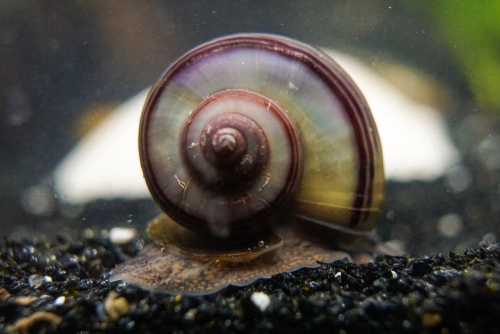
Proactive health monitoring is key to ensuring a long mystery snail lifespan in aquariums. Regular observation for signs of shell deterioration or behavioral changes can indicate health problems. Maintaining a stress-free environment is crucial for preventing diseases.
Mystery snails have an average lifespan of 1 to 2 years, although, with proper care, they can live up to 3 years. The longevity of these snails depends on several factors, such as water quality, diet, and overall tank conditions.
A healthy mystery snail will have a well-developed shell and exhibit regular active behaviour, such as exploring the aquarium and seeking food. The gills of snails play a critical role in respiration, but they may be susceptible to various parasites. When parasites infect the gills, they can hinder the snail’s ability to breathe correctly, leading to health complications.
Several factors can affect a mystery snail’s health, including diseases and illnesses. One common health issue among snails is the parasitic infection of their gills.
Parasites can invade the mystery snail’s body and thrive on their nutrition. It is crucial to monitor the snail’s health and watch for signs of disease, such as reduced activity, excessive slime production, and lack of appetite.
To maintain the health of mystery snails, providing a clean aquarium environment is essential. Regularly monitoring water parameters, such as pH, ammonia, nitrate, and nitrite levels, can help keep the snails in optimal condition.
Additionally, a balanced diet, including various plant-based foods and calcium supplements, can support healthy shell growth and overall well-being.
While mystery snails can exhibit resilience, it is crucial to take proactive measures to ensure their continued health and longevity. By providing appropriate care, maintaining a clean environment, and delivering a proper, balanced diet, aquarists can contribute to the thriving life of these fascinating freshwater snails.
Species and Varieties
Mystery snails, sometimes called Apple snails, belong to the Pomacea genus and are native to South America. They can be found in Brazil, Paraguay, Bolivia, and Peru.
Although there are numerous species within this genus, the most common and widespread species in the aquarium trade is the Pomacea Diffusa, known as the Spike-Topped Apple snail.
These snails are quite diverse in their appearance, offering a range of shell colours and patterns. Some of the most popular varieties include the Purple Mystery Snail, Ivory Mystery Snail, Golden Mystery Snail, Jade Mystery Snail, Blue Mystery Snail, Wild/Black Mystery Snail, and Dark Striped Olive (Walnut) Mystery Snail.
Mystery snails are valued by aquarium hobbyists not only for their beauty and variety but also for their ability to help keep tanks clean by consuming algae and excess food.
They are peaceful, herbivorous, and slow-moving creatures that are easy to care for, making them a popular choice for beginner and experienced fishkeepers.
While their natural habitat consists of slow-moving freshwaters, such as rivers, lakes, and swamps, they have also adapted well to life in home aquariums.
To ensure their proper care, fishkeepers must provide them with a clean environment, a balanced diet, and suitable tank mates that won’t cause them any harm.
Invasive Status and Controversies
The mystery snail, specifically the Chinese mystery snail (Cipangopaludina chinensis) and the banded mystery snail (Vivaparus georgianus), are considered invasive species in the United States.
These freshwater snails have been introduced into non-native environments and have caused significant disruptions to local ecosystems.
The Chinese mystery snail is a large, smooth-shelled snail with a tan to brown shell that can grow up to 2 inches long, featuring 6-7 whorls. It poses a threat to native wildlife, as it can clog water-intake pipes and compete with native snails for food, adversely affecting aquatic food webs.
On the other hand, the banded mystery snail is characterised by its olive-green shell with 4-5 whorls and distinct sutures. It can grow up to 1 3/4 inches in size and has four reddish bands circling the shell. This invasive species may invade largemouth bass nests, increasing the mortality rate of their eggs.
Chinese and banded mystery snails are regulated invasive species in various states, including Minnesota. It is legal to possess, sell, buy, and transport them. However, they cannot be introduced into a free-living state, like being released or planted in public waters.
Furthermore, some confusion may arise between invasive mystery snails and native apple snails. Apple snails are a family of large freshwater snails, and some species can also be invasive. To differentiate between these species, observing their shells, colouration, and size is essential.
Optimizing Water Parameters for Mystery Snails

Fine-tuning water quality is crucial for extending the mystery snail lifespan. Regular checks and adjustments of water hardness are essential, as these snails thrive in moderately hard water. Keeping ammonia and nitrite levels at zero and maintaining low nitrate levels through frequent water changes are vital for their health.
Advanced Dietary Practices
For optimal health, mystery snail food should include high-calcium items and occasional protein-rich treats. Incorporating blanched leafy greens, calcium-enriched pellets, and occasional treats like bloodworms can provide a well-balanced diet. This variety not only ensures proper nutrition but also encourages natural foraging behavior.
Creating a Stimulating Environment
An ideal habitat for mystery snails includes various substrate types and abundant live plants. Adding elements like driftwood and smooth rocks can promote algae growth, a primary food source for these snails. Providing hiding spots with decorations or plant cover creates a stimulating environment, reflecting their natural habitat.
Similar Freshwater Snails
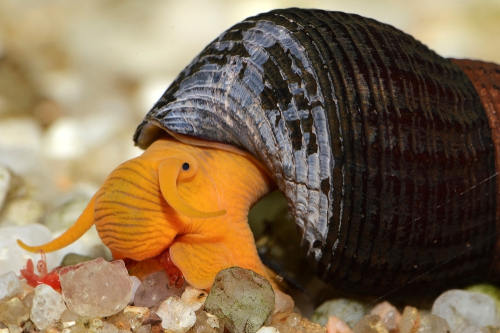
Mystery snails are popular for freshwater aquariums, but there are other snails to consider. Nerite snails are adaptable to various water parameters and can thrive in small aquariums. They rarely grow more significant than an inch in diameter.
Another interesting freshwater snail is the Ramshorn snail. These snails have distinctive shell shapes that resemble a ram’s horns. Ramshorn snails come in various colours, such as black and red, with beautiful spiralling shells adorned with black stripes. Like mystery snails, they are native to South and Central America.
Tiger Nerite snails, also known as the mystery snail, are native to South and Central America. They have a shell width of around 50 mm and display various colours, such as yellow, gold, blue, purple, orange, greenish, black, white, ivory, and brown.
Frequently Asked Questions
Are mystery snails beneficial for aquariums?
Yes, mystery snails are beneficial for aquariums. They are easy to care for, fun to observe and help keep your tank clean by snacking on algae throughout the day. Their ability to consume excess food, waste, and algae makes them a popular addition to many home aquariums worldwide.
What is the average lifespan of a mystery snail?
Mystery snails have an average lifespan of about one to two years. However, their life expectancy can vary depending on factors such as water quality, diet, and stress levels.
Can mystery snails coexist with betta fish?
Mystery snails can coexist with betta fish, as both species are generally peaceful and do not pose a significant threat to each other. Bettas usually keep to themselves and do not bother mystery snails, making them suitable companions in a home aquarium.
Is it difficult to maintain mystery snails?
Mystery snails are considered easy to maintain, as they do not require specialised care or equipment. They can thrive in a pH range of 6.5 to 7.5 and a temperature range of 68 to 84 degrees Fahrenheit (20° to 28°C).
A diet of algae wafers, blanched vegetables, and other suitable food items will help keep them healthy and active in your aquarium.
How do mystery snails reproduce?
Mystery snails reproduce through a process called oviposition. The female snail will lay a clutch of eggs above the waterline in the aquarium. The eggs will then develop within these clutches and hatch after two to four weeks.
Baby mystery snails will eventually drop into the water, where they continue to grow and mature.
What do mystery snails eat?
Mystery snails are opportunistic feeders and have a varied diet. They consume algae, detritus, leftover fish food, and even dead plant matter. They also enjoy algae wafers, blanched vegetables (such as zucchini, carrot, and spinach), and melted aquarium plants.
Key Takeaways
- Mystery snails are attractive and beneficial to freshwater aquarium residents due to their algae-eating habits and peaceful nature.
- Proper care involves meeting their dietary needs and providing the right tank conditions and compatible tank mates.
- Their unique shell design and variety of colour variations make them a visually appealing addition to aquariums.
Check out these other related posts:

Veteran fish keeper and keen hobbyist with a serious case of MTS. My midlife crisis was the establishment of a fish room, much to my wife’s horror. Little does she know it could be worse!!


